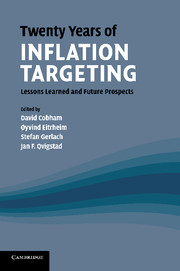Book contents
- Frontmatter
- Contents
- List of figures
- List of tables
- List of contributors
- 1 Introduction
- 2 Welcome remarks: a Norwegian perspective
- 3 Reflections on inflation targeting
- 4 Inflation targeting at twenty: achievements and challenges
- 5 Inflation targeting twenty years on: where, when, why, with what effects and what lies ahead?
- 6 How did we get to inflation targeting and where do we need to go to now? A perspective from the US experience
- 7 Inflation control around the world: why are some countries more successful than others?
- 8 Targeting inflation in Asia and the Pacific: lessons from the recent past
- 9 Inflation targeting and asset prices
- 10 The optimal monetary policy instrument, inflation versus asset price targeting, and financial stability
- 11 Expectations, deflation traps and macroeconomic policy
- 12 Heterogeneous expectations, learning and European inflation dynamics
- 13 Inflation targeting and private sector forecasts
- 14 Inflation targeting, transparency and inflation forecasts: evidence from individual forecasters
- 15 Gauging the effectiveness of quantitative forward guidance: evidence from three inflation targeters
- 16 Macro-modelling with many models
- 17 Have crisis monetary policy initiatives jeopardised central bank independence?
- 18 Inflation targeting: learning the lessons from the financial crisis
- 19 The financial crisis as an opportunity to strengthen inflation-targeting frameworks
- 20 ‘Leaning against the wind’ is fine, but will often not be enough
- 21 Inflation targeting, capital requirements and ‘leaning against the wind’: some comments
- Index
5 - Inflation targeting twenty years on: where, when, why, with what effects and what lies ahead?
Published online by Cambridge University Press: 05 October 2010
- Frontmatter
- Contents
- List of figures
- List of tables
- List of contributors
- 1 Introduction
- 2 Welcome remarks: a Norwegian perspective
- 3 Reflections on inflation targeting
- 4 Inflation targeting at twenty: achievements and challenges
- 5 Inflation targeting twenty years on: where, when, why, with what effects and what lies ahead?
- 6 How did we get to inflation targeting and where do we need to go to now? A perspective from the US experience
- 7 Inflation control around the world: why are some countries more successful than others?
- 8 Targeting inflation in Asia and the Pacific: lessons from the recent past
- 9 Inflation targeting and asset prices
- 10 The optimal monetary policy instrument, inflation versus asset price targeting, and financial stability
- 11 Expectations, deflation traps and macroeconomic policy
- 12 Heterogeneous expectations, learning and European inflation dynamics
- 13 Inflation targeting and private sector forecasts
- 14 Inflation targeting, transparency and inflation forecasts: evidence from individual forecasters
- 15 Gauging the effectiveness of quantitative forward guidance: evidence from three inflation targeters
- 16 Macro-modelling with many models
- 17 Have crisis monetary policy initiatives jeopardised central bank independence?
- 18 Inflation targeting: learning the lessons from the financial crisis
- 19 The financial crisis as an opportunity to strengthen inflation-targeting frameworks
- 20 ‘Leaning against the wind’ is fine, but will often not be enough
- 21 Inflation targeting, capital requirements and ‘leaning against the wind’: some comments
- Index
Summary
The ability to deal with demand shocks and financial crises can be enhanced by a commitment to an explicit [inflation] target.
Carl Walsh (2009a: 1)Today, inflation targeting is being put to the test – and it will almost certainly fail.
Joseph Stiglitz (2008: 1)Introduction
Two decades have passed since the Reserve Bank of New Zealand pioneered modern monetary policy practice by adopting inflation targeting. Since then, IT has gained followers and reputation, becoming the monetary regime of choice among many central bankers and academics. This preference has been revealed by the fact that no central bank endowed with monetary sovereignty that has adopted IT since 1989 has abandoned it – until now, at least. Although at the time of this writing, in the midst of the worst financial crisis and global recession in a lifetime, it seems a bit adventurous to provide a firm forecast on IT's future prospects, my bet is that Walsh will be proved right in his quote and Stiglitz wrong.
The widespread adoption of IT as the frontier monetary regime around the world poses some questions about the economic and institutional factors that lead countries to adopt and sustain IT, and about the potential policy and performance benefits of IT. On what drives countries to implement IT, earlier studies point towards the role of initial institutional and economic conditions satisfied when adopting and maintaining IT adoption (see, for example, Mishkin and Schmidt-Hebbel 2007a).
- Type
- Chapter
- Information
- Twenty Years of Inflation TargetingLessons Learned and Future Prospects, pp. 57 - 89Publisher: Cambridge University PressPrint publication year: 2010
- 6
- Cited by

